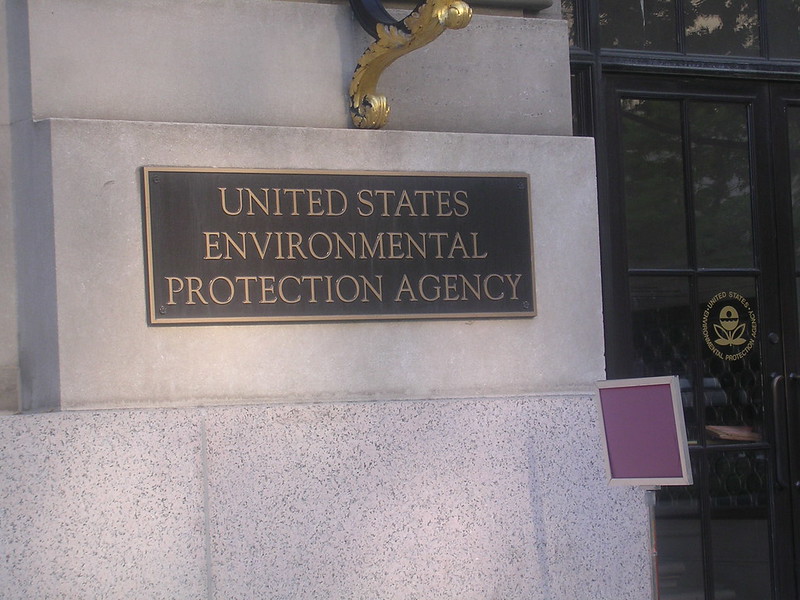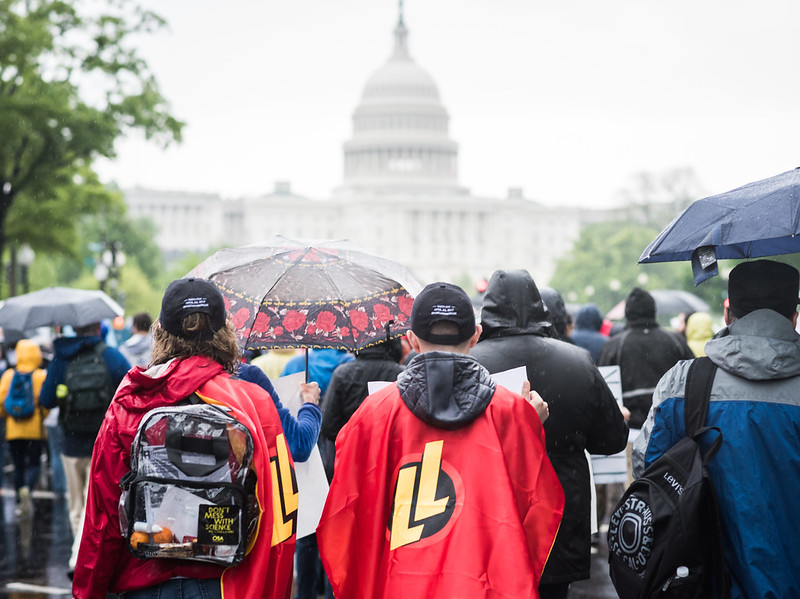The Trump administration is rushing to approve dozens of eleventh-hour policy changes. Among them: The Justice Department is fast-tracking a rule that could reintroduce firing squads and electrocutions to federal executions.

This story originally appeared on ProPublica.
Six days after President Donald Trump lost his bid for reelection, the U.S. Department of Agriculture notified food safety groups that it was proposing a regulatory change to speed up chicken factory processing lines—a change that would allow companies to sell more birds. An earlier USDA effort had broken down on concerns that it could lead to more worker injuries and make it harder to stop germs like salmonella.
Ordinarily, a change like this would take about two years to go through the cumbersome legal process of making new federal regulations. But the timing has alarmed food and worker safety advocates, who suspect the Trump administration wants to rush through this rule in its waning days.
Even as Trump and his allies officially refuse to concede the Nov. 3 election, the White House and federal agencies are hurrying to finish dozens of regulatory changes before Joe Biden is inaugurated on Jan. 20.
The rules range from long-simmering administration priorities to last-minute scrambles and affect everything from creature comforts like shower heads and clothes washers, to life-or-death issues like federal executions and international refugees. They impact everyone from the most powerful, such as oil drillers, drugmakers and tech startups, to the most vulnerable, such as families on food stamps, transgender people in homeless shelters, migrant workers and endangered species. (ProPublica is tracking those regulations as they move through the rule-making process.)
Every administration does some version of last-minute rule-making, known as midnight regulations, especially with a change in parties. It’s too soon to say how the Trump administration’s tally will stack up against predecessors. But these final weeks are solidifying conservative policy objectives that will make it harder for the Biden administration to advance its own agenda, according to people who track rules developed by federal agencies.
“The bottom line is the Trump administration is trying to get things published in the Federal Register, leaving the next administration to sort out the mess,” said Matthew Kent, who tracks regulatory policy for left-leaning advocacy group Public Citizen. “There are some real roadblocks to Biden being able to wave a magic wand on these.”
In some instances the Trump administration is using shortcuts to get more rules across the finish line, such as taking less time to accept and review public feedback.
It’s a risky move. On the one hand, officials want to finalize rules so that the next administration won’t be able to change them without going through the process all over again. On the other, slapdash rules may contain errors, making them more vulnerable to getting struck down in court.
The Trump administration is on pace to finalize 36 major rules in its final three months, similar to the 35 to 40 notched by the previous four presidents, according to Daniel Perez, a policy analyst at the George Washington University Regulatory Studies Center.
In 2017, Republican lawmakers struck down more than a dozen Obama-era rules using a fast-track mechanism called the Congressional Review Act. That weapon may be less available for Democrats to overturn Trump’s midnight regulations if Republicans keep control of the Senate, which will be determined by two Georgia runoffs. Still, a few GOP defections could be enough to kill a rule with a simple majority.
“This White House is not likely to be stopping things and saying on principle elections have consequences, let’s respect the voters’ decision and not rush things through to tie the next guys’ hands,” said Susan Dudley, who led the Office of Information and Regulatory Affairs in the Office of Management and Budget at the end of the George W. Bush administration. “One concern is the rules are rushed so they didn’t have adequate analysis or public comment, and that’s what we’re seeing.”
The Trump White House didn’t respond to requests for comment on which regulations it’s aiming to finish before Biden’s inauguration. The Biden transition team also didn’t respond to questions about which of Trump’s parting salvos the new president would prioritize undoing.
Many of the last-minute changes would add to the heap of changes throughout the Trump administration to pare back Obama-era rules and loosen environmental and consumer protections, all in the name of shrinking the government’s role in the economy.
“Our proposal today greatly furthers the Trump administration’s regulatory reform efforts, which together have already amounted to the most aggressive effort to reform federal regulations of any administration,” said Brian Harrison, the chief of staff for the Department of Health and Human Services, on Nov. 4.
Harrison was unveiling a new proposal to automatically purge regulations that are more than 10 years old unless the agency decides to keep them.
For that proposal to become finalized before Jan. 20 would be an exceptionally fast turnaround. But Harrison left no doubt about that goal.
“The reason we’re doing this now is because,” he said, “we at the department are trying to go as fast as we can in hopes of finalizing the rule before the end of the first term.”
Easier to Pollute, Harder to Immigrate
One proposal has raced through the process with little notice but unusual speed—and deadly consequences. This rule could reintroduce firing squads and electrocutions for federal executions, giving the government more options for administering capital punishment as drugs used in lethal injections become unavailable. The Justice Department surfaced the proposal in August and accepted public comments for only 30 days, instead of the usual 60. The rule cleared White House review on Nov. 6, meaning it could be finalized any day. The Justice Department didn’t respond to a request for comment.
Once finalized, this rule might never be put into practice. The Trump administration executed a federal prisoner in Indiana on Nov. 19 and plans five more executions before Jan. 20, all with lethal injections. After that, Biden has signaled he won’t allow any federal executions and will push to eliminate capital punishment for federal crimes.
Other less dramatic-sounding rules could prove harder to unravel and have broader consequences. In particular, the Environmental Protection Agency is on the cusp of finalizing several rules that would make it harder to justify pollution restrictions or lock in soot levels for at least five years. The agency wants to keep the soot standard unchanged over the objections of independent scientific advisers and despite emerging evidence that links particulate pollution to additional coronavirus deaths.

An EPA spokesman declined to comment on the timing of these rules.
“EPA continues to advance this administration’s commitment to meaningful environmental progress while moving forward with our regulatory reform agenda,” the spokesman, James Hewitt, said.
While those rules have developed over years, others were launched later and officials are taking shortcuts to finish in time. Reviews by the White House’s Office of Information and Regulatory Affairs that normally take 90 days or more are now wrapping up in as few as five days.
The White House is close to completing several rules that would extend Trump’s record of restricting immigration and make the changes harder for the Biden administration to reverse. The pending rules would make it more difficult to claim asylum by excluding people with criminal convictions (even those that have been expunged), drastically shortening the application time and giving immigration judges more latitude to pick and choose what evidence to consider. The departments of Justice and Homeland Security didn’t respond to requests for comment.
Some rules read like Trump’s stump speeches translated into policy legalese. The Department of Energy is racing to loosen efficiency standards for showerheads and laundry machines, evoking Trump’s recurring bits about bathroom water pressure.
“Do you ever get under a shower and no water comes out?” Trump said at an October rally in Nevada. “And me, I want that hair to be so beautiful.”
Notably, the trade group representing washer manufacturers actually opposes the administration’s proposal, saying it’s unnecessary because many machines already have short-cycle options. The proposed rule is supported by small-government advocates such as the Competitive Enterprise Institute. Water and electric companies warn it could lead to higher consumption and waste. The Energy Department didn’t respond to a request for comment.
The administration is also bucking business groups with proposals to restrict high-skilled immigration; in October, the departments of Homeland Security and Labor unveiled regulations to raise wage and education requirements for H-1B visas, which are often used in the information-technology industry. (The proposal drew opposition from the Small Business Administration, saying the higher costs would stifle innovation and growth.)
But while raising the wage scale for skilled immigrants, the administration is pushing a different new rule to lower wages for “low-skilled” immigrant farmworkers.
A spokesperson for U.S. Citizenship and Immigration Services (part of DHS) told ProPublica that “Any delay in responding to an economic emergency and high unemployment in a way that protects American workers and ensures the H-1B program is administered consistent with statutory requirements could cause real harm to the U.S. economy.”
The Department of Labor didn’t respond to requests for comment.
Other rules are more clearly accommodating powerful business interests. A rule completed on Nov. 13 would restrict pension managers from considering social and environmental impacts (known in the industry as ESG) when choosing investments.
Another Labor Department rule would make it easier for companies like Uber to withhold benefits by classifying workers as independent contractors instead of full employees. Both proposals had a truncated public comment period of only 30 days. A spokesman said the agency considers all comments regardless of how long the period lasts and that the department is working to complete all regulations on its agenda.
Chicken Plants on the Fast Track
Such shortcuts still might not be enough to finish some new rules that are just starting out now. Still, these tactics have raised alarms about the USDA’s proposal to speed up chicken factories, even though a regulatory change like that would ordinarily take two years or more. The USDA has not provided a timeline, and the proposal is not yet public while the White House reviews it. An agency spokesman said the department is following the standard process.
The rules change has the support of the National Chicken Council, an industry trade group, which argues that the timing is not political.
Spokesman Tom Super called the proposal “the most deliberative and studied proposed rule that has ever been issued. It spans three decades, four administrations—Republican and Democrat—countless scientific studies and various court cases.”
The USDA has been laying the groundwork for the rule change for years. Even though safety concerns scuttled the USDA’s previous attempt to raise speeds from 140 birds per minute to 175, in 2018 the agency started granting one-off waivers to individual plants that sought permission to run faster.
The performance of those plants could equip the USDA to argue that the speed limit should go up in all of them. Although the agency has not yet released its formal justification for the new proposal, officials have referenced a new study in the journal Poultry Science that concluded that inspectors in plants with faster speeds did not detect higher average levels of salmonella contamination.
The USDA funded the study through a no-bid contract worth up to $500,000 awarded in 2018 to Louis Anthony “Tony” Cox Jr., a statistician who consults for business interests such as the American Petroleum Institute and the American Chemistry Council, according to the Center for Investigative Reporting.
Cox declined to share data he secured exclusively from the USDA or to be interviewed for this article. In emailed answers to written questions, he defended his methodology but acknowledged there’s room for further study.
Other evidence, however, suggests faster speeds could make chicken less safe to eat. In a September article in the journal Frontiers in Veterinary Science, USDA researcher Jeremy Marchant-Forde and a co-author found that USDA inspectors threw out record-low amounts of chicken when the agency let more plants speed up since May. The authors called this “a major threat to public health” to the extent it suggests inspectors were failing to find contaminated carcasses (rather than the birds having suddenly become much cleaner). But the authors cautioned they’re not food safety experts and declined to comment further.
While the food safety issues are debated, there’s already clear evidence that running faster lines poses higher worker risks, both repetitive strain injuries like carpal tunnel and traumatic injuries like cuts and amputations. But the USDA maintains that it is responsible only for food safety; worker safety is the job of the Occupational Safety and Health Administration.
That’s exactly the kind of interagency dialogue that the White House is supposed to coordinate when planning new regulations—and the kind of process that could be shortchanged in the final months of an administration, according to the American Public Health Association’s Occupational Health and Safety Section. An OSHA spokeswoman declined to say whether the agency has weighed in on the USDA’s proposal. The National Institute for Occupational Safety and Health, part of the Centers for Disease Control and Prevention, has not yet commented on the proposal but plans to, a spokeswoman said.
“This last-minute push for an ill-advised rule change could be deadly for essential workers in slaughterhouses,” said Jessica Martinez, co-executive director of the National Council for Occupational Safety and Health, an advocacy group for safer working conditions.

Leasing Against the Clock
Since many finalized Trump rules are currently under court challenges, the Biden administration might be able to let some of them wither or die in litigation—especially where judges have blocked or struck down the regulations and the new Justice Department could decide not to appeal.
It will also have to wrestle with other changes the Trump administration is rushing to implement, using tactics other than rule-making.
The Trump administration is also pressing ahead with opening up more federal lands to oil and gas development, despite low prices, sluggish demand and complaints from environmental groups that drilling would encroach on wildlife habitats and national parks. Bids are starting at just $2 an acre for more than 445,000 acres of public land with leases for sale to energy companies through the Bureau of Land Management, according to data from EnergyNet.com.
The leases could expand dramatically as the BLM finalizes a plan to allow oil and gas drilling on an additional 6.8 million acres of the National Petroleum Reserve in Alaska, a habitat for bears, musk oxen, caribou and birds. Spokespeople for the BLM didn’t respond to a request for comment.
Separately, the Interior Department will open up drilling in the Arctic National Wildlife Refuge. The agency is spending 30 days asking companies for bids, and then sales need another 30 days to take effect—just enough time to beat the clock before the inauguration.
An Interior Department spokesman said the agency is taking “a significant step” to implement Congress’ direction in the 2017 Republican tax bill to start drilling in ANWR.
“The department will continue to implement President Trump’s agenda to create more American jobs, protect the safety of American workers, support domestic energy production and conserve our environment,” the spokesman, Conner Swanson, said. He didn’t say whether the leases would be done by Jan. 20.
Leases that have not yet been issued would be easier for the Biden administration to drop, but even finalized leases could be withdrawn if officials decide they were improperly issued or too environmentally dangerous, according to Erik Grafe, an attorney with Earthjustice in Anchorage. (Leaseholders might argue they deserve to be compensated.)
In addition, even once leases are issued, companies need permits and authorizations before actually taking action on the ground, Grafe said. Those steps would take more time and face legal challenges. Earthjustice and other groups are already suing to block the Arctic drilling program as a whole.
“We have been protecting this place forever,” said Bernadette Demientieff, executive director of the Gwich’in steering committee representing indigenous hunting communities in northeast Alaska. “This fight is far from over, and we will do whatever it takes to defend our sacred homelands.”
Lydia DePillis, Dara Lind, Lisa Song, Jake Kincaid, Doris Burke, Annie Waldman and Zipporah Osei contributed reporting.
You may also like:





